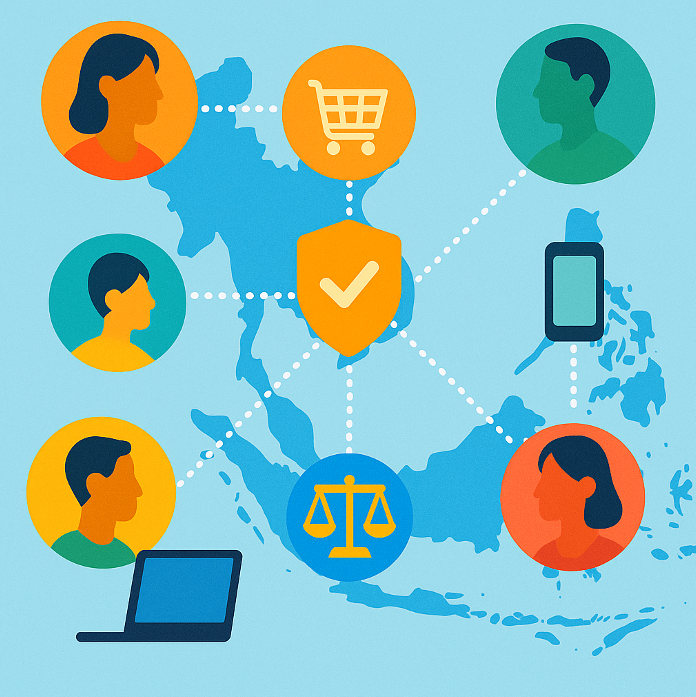By Nam Phuong Ngo
This blog post is adapted from the author’s presentation at the 10th Biennial Conference of the Asian Society of International Law in Hanoi, Vietnam from 9 to 10 October 2025.
Anyone who has booked a hotel online knows the rush: the bold flashing labels promising the “cheapest” deal, or the five-minute timer that ticks down as you enter your details. These features may help users compare prices or manage time, but sometimes they cross a line. On Agoda’s website in Singapore, the authorities recently found that some of these designs went too far. Hotels marked as “Best Match” or “Agoda Preferred” were partly ranked based on how much commission they paid to Agoda. A “Cheapest” label did not always point to the lowest-priced option, and the short countdown timer created a false sense of urgency for consumers to complete their bookings. The Competition and Consumer Commission of Singapore (CCCS) raised concerns that these designs could mislead consumers. Agoda cooperated and changed its interface. However, no fine was issued, and there is no public evidence of disgorgement of the wrongful gains made through those designs. The case shows both the progress and the limits of how ASEAN countries handle these “dark patterns”: the problem is recognised, but legal responses remain minimal.
Dark patterns and the ASEAN context
In July 2024, the ASEAN Committee on Consumer Protection (ACCP) launched a Regional Information Campaign on Dark Patterns and Deceptive Designs, reflecting growing awareness of how online interfaces can manipulate users’ choices. The term “dark patterns,” coined by Harry Brignull, refers to design elements that benefit service providers by manipulating users into decisions that they might not make with full information and free choice. Such designs exploit information asymmetries and consumer cognitive biases, undermining informed consent and consumer autonomy (ICO, CMA, and DRCF, 2023).
ASEAN’s e-commerce market is among the fastest-growing in the world, projected to reach over US$230 billion by 2026. This growth brings opportunity, but also new risks. Manipulation by design can spread across borders faster than most regulators can react (Hayati, 2024). Although the ASEAN Guidelines on Consumer Protection in E-Commerce explicitly acknowledge the “so-called dark patterns” as a consumer risk, consumer protection against dark patterns in e-commerce across the region remains fragmented and uneven. Some countries are starting to act, but others still rely on broad “unfair practice” rules written for offline markets.
This mismatch between digital innovation and legal adaptation motivated this study. Specifically, this study seeks to understand how the region is responding to these manipulative design practices, and what it could learn from emerging models elsewhere.
Mapping the region’s legal responses
This study examines 14 jurisdictions, including the 10 ASEAN Member States, China, India, Japan, and South Korea, focusing on three main areas of law: e-commerce regulations, consumer protection laws, and data protection laws. To compare such diverse legal systems, I used a three-dimensional framework that considers whether dark patterns are recognised in law, whether enforcement has been effective, and whether countries cooperate on cross-border cases. This approach highlights patterns and gaps rather than ranking countries, offering a snapshot of where the jurisdictions stand and where progress is needed.
Emerging efforts, uneven progress
Across Asia, regulation of dark patterns is still in its early stages. Only a few countries, notably South Korea, India, and the Philippines, have adopted explicit rules or provided guidance addressing dark patterns. Most others rely on broad provisions that prohibit “misleading” or “unfair” conduct, which can cover some dark patterns but lack clarity in digital contexts.
Enforcement, if any, remains largely corrective rather than punitive. Regulators often prefer warnings or voluntary undertakings to first-instance fines or sanctions. Singapore’s recent Agoda case is a prime example: the authority intervened, the company cooperated, and no monetary fine was issued. This approach shows that awareness is growing, but deterrence is still weak.
Cross-border enforcement also remains limited. While some ASEAN countries participated in the ICPEN Dark Patterns in Subscription Services Sweep 2024 and the GPEN Deceptive Design Patterns Sweep, coordinated investigations and enforcement in the region are still rare. In a digital economy where platforms operate seamlessly across borders, this lack of coordination leaves consumers vulnerable to manipulative practices that move as fast as technology itself.
From global rules to regional action
The good news is that ASEAN does not need to start from scratch. International and regional frameworks already support stronger action against dark patterns. The WTO’s General Agreement on Trade in Services (GATS) allows governments to regulate deceptive or fraudulent online practices to protect consumers and privacy, provided that these rules are not applied in an arbitrary or discriminatory manner or used as a disguised restriction on trade (Article XIV). The Regional Comprehensive Economic Partnership (RCEP) and the ASEAN Agreement on Electronic Commerce both require members to prevent misleading online conduct and cooperate on enforcement. The ASEAN Guidelines on Consumer Protection in E-Commerce explicitly identify dark patterns as consumer risks to be addressed. Together, these frameworks give ASEAN countries not only legal legitimacy but also the responsibility to build trustworthy digital markets grounded in fairness and transparency.
The way forward
Dark patterns are now part of daily life in ASEAN’s digital economy, shaping how people shop, make bookings, and give consent online. My study suggests that while awareness of their risks is growing, regulation and enforcement remain uneven. The legal and policy foundations for action already exist, but they need to be activated. The next step for ASEAN is not only to update national laws but also to coordinate regionally, ensuring that no jurisdiction becomes a safe haven for digital manipulation. Building a fairer digital environment will take time, but it begins with one shared goal: making fairness the default design in ASEAN’s online marketplace – so that transparency, not manipulation, defines the way people click, scroll, and buy.
About the author
Miss Nam Phuong Ngo is a PhD researcher in law at the University of Liverpool and is a Policy Group Member at the Centre for AI and Digital Policy (CAIDP). This post is adapted from her paper presented at the 10th Biennial Conference of the Asian Society of International Law, October 9-10, 2025. Her interests include competition law, consumer protection law and emerging technology regulations. She can be reached at P.N.Ngo@liverpool.ac.uk and https://uk.linkedin.com/in/phuongnamngo for any inputs or suggestions.





